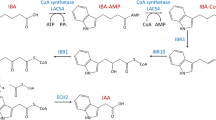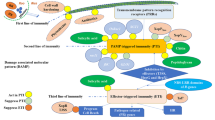Abstract
Camalexin production was compared in 24 ecotypes of Arabidopsis thaliana. Detached Arabidopsis leaves were inoculated with Cochliobolus carbonum, an incompatible pathogen of Arabidopsis, to test the ability of each ecotype to produce camalexin. Whole plants were inoculated with Alternaria brassicicola, a crucifer pathogen, to determine if there was a correlation between the ability of an ecotype to produce camalexin and its resistance to A. brassicicola. All ecotypes were capable of producing camalexin, but the amounts produced relative to the Columbia ecotype (used as a standard) varied within and among ecotypes, and among experiments. Different degrees of resistance to A. brassicicola were observed among ecotypes, both macroscopically and microscopically. Extraction of A. brassicicola-inoculated leaves revealed that only four ecotypes (two resistant and two susceptible) produced easily detectable amounts of camalexin in response to this pathogen. TLC plate bioassays suggested that A. brassicicola was relatively insensitive to camalexin, thus casting some doubt on the importance of this compound in defense. These studies suggest that the role of camalexin in disease resistance varies among different Arabidopsis populations in nature, and they provide some clues to other possible determinants of resistance to A. brassicicola.
Similar content being viewed by others
REFERENCES
Agrios, G. N. 1997. Plant Pathology, 4th ed. Academic Press, New York.
Ayer, W. A., Craw, P. A., Ma, Y., and Miao, S. 1992. Synthesis of camalexin and related phytoalexins. Tetrahedron 48:2919–2924.
Browne, L. M., Conn, K. L., Ayer, W. A., and Tewari, J. P. 1991. The camalexins: new phytoalexins produced in the leaves of Camelina sativa (Cruciferae). Tetrahedron 47:3909–3914.
Callaway, A., Liu, W. N., Andrianov, V., Stenzler, L., Zhao, J. M., Wettlaufer, S., Jayakumar, P., and Howell, S. H. 1996. Characterization of cauliflower mosaic virus (CaMV) resistance in virus-resistant ecotypes of Arabidopsis. Mol. Plant–Microbe Interact. 9:810–818.
Conn, K. L., Tewari, J. P., and Dahiya, J. S. 1988. Resistance to Alternaria brassicae and phytoalexin elicitation in rapeseed and other crucifers. Plant Sci. 56:21–25.
Conn, K. L., Browne, L. M., Tewari, J. P., and Ayer, W. A. 1994. Resistance to Rhizoctonia solani and presence of antimicrobial compounds in Camelina sativa roots. J. Plant Biochem. Biotechnol. 3:125–130. 2138 KAGAN AND HAMMERSCHMIDT
Cooke, D. E. L., Jenkins, P. D., and Lewis, D. M. 1997. Production of phytotoxic spore germination liquids by Alternaria brassicae and A. brassicicola and their effect on species of the family Brassicaceae. Ann. Appl. Biol. 131:413–426.
Dempsey, D. A. 1996. Characterization of the Responses of Arabidopsis thaliana to Turnip Crinkle Virus. PhD dissertation. Rutgers State University, New Jersey.
Dempsey, D. A., Pathirana, M. S., Wobbe, K. K., and Klessig, D. F. 1997. Identification of an Arabidopsis locus required for resistance to turnip crinkle virus. Plant J. 11:301–311.
Deverall, B. J. 1982. Introduction, in J. A. Bailey and J. W., Mansfield (eds). Phytoalexins. Blackie, Glasgow, United Kingdom.
Ellis, M. B. 1968. Alternaria brassicicola. CMI Description of Pathogenic Fungi and Bacteria, No. 163.
Fuchs, H. and Sacristan, M. D. 1996. Identification of a gene in Arabidopsis thaliana controlling resistance to clubroot (Plasmodiophora brassicae) and characterization of the resistance response. Mol. Plant–Microbe Interact. 9:91–97.
Gerson, E. A. and Kelsey, R. G. 1998. Variation of piperidine alkaloids in ponderosa (Pinus ponderosa) and lodgepole pine (P. contorta) foliage from central Oregon. J. Chem. Ecol. 24:815–827.
Glazebrook, J. and Ausubel, F. M. 1994. Isolation of phytoalexin-deficient mutants of Arabidopsis thaliana and characterization of their interactions with bacterial pathogens. Proc. Natl. Acad. Sci. USA 91:8955–8959.
Glazebrook, J., Zook, M., Mert, F. M., Kagan, I., Rogers, E. E., Crute, I. R., Holub, E. B., Hammerschmidt, R., and Ausubel, F. M. 1997. Phytoalexin-deficient mutants of Arabidopsis reveal that PAD4 encodes a regulatory factor and that four PAD genes contribute to downy mildew resistance. Genetics 146:381–392.
Hammerschmidt, R. 1999. Phytoalexins: What have we learned after 60 years? Annu. Rev. Phytopathol. 37:285–306.
Holub, E. B., Brose, E., Tor, M., Clay, C., Crute, I. R., and Beynon, J. L. 1995. Phenotypic and genotypic variation in the interaction between Arabidopsis thaliana and Albugo candida. Mol. Plant-Microbe Interact. 8:916–928.
Jimenez, L. D., Ayer, W. A., and Tewari, J. P. 1997. Phytoalexins produced in the leaves of Capsella bursa-pastoris (shepherd' purse). Phytoprotection 78:99–103.
Jirage, D., Tootle, T. L., Reuber, T. L., Frost, L. N., Feys, B. J., Parker, J. E., Ausubel, F. M., and Glazebrook, J. 1999. Arabidopsis thaliana PAD4 encodes a lipase-like gene that is important for salicylic acid signaling. Proc. Natl. Acad. Sci. USA 96:13583–13588.
Kagan, I. A. and Hammerschmidt, R. 2001. Pitfalls in screening for camalexin-deficient mutants: effects of kinetics, pathogen choice, and inoculum concentration on apparent camalexin accumulation in wild-type (Columbia) and pad2 Arabidopsis. Physiol. Mol. Plant Pathol. 59:119–127.
Kagan, I. A., Zook, M. N., and Hammerschmidt, R. 1997. Accumulation of camalexin and a putative precursor in wild-type and a phytoalexin-deficient mutant of Arabidopsis. Phytopathology 87:S50 (abstract).
Knogge, W. 1996. Fungal infection of plants. Plant Cell 8:1711–1722.
Koornneef, M. and Van Loenen Martinet, E. P. 1983. The isolation of a 5-methyltryptophaninsensitive mutant by selection at the seedling stage. Arabidopsis Information Service 20:104–408. [Online] Available http://www.arabidopsis.org/ais/1983/koorn-1983-aabmm.html
KuĆ, J. 1995. Phytoalexins, stress metabolism, and disease resistance in plants. Annu. Rev. Phytopathol. 33:275–297.
Lazarovits, G., Brammall, R. A., and Ward, E.W. B. 1982. Bioassay of fungitoxic compounds on thin-layer chromatograms with Pythium and Phytophthora species. Phytopathology 72:61–63.
Leisner, S.M. and Howell, S.H. 1992. Symptom variation in different Arabidopsis thaliana ecotypes produced by cauliflower mosaic virus. Phytopathology 82:1042–1046.
Mauch-mani, B., Croft, K. P. C., and Slusarenko, A. 1993. The genetic basis of resistance of Arabidopsis thaliana L. Heyhn to Peronospora parasitica, in K. R. Davis and R. Hammerschmidt (eds.). Arabidopsis thaliana as a Model for Plant–Pathogen Interactions. The American Phytopathological Society, St. Paul, Minnesota.
Mhiri, C., Morel, J.-B., Vernhettes, S., Casacuberta, J. M., Lucas, H., and Grandbastien, M.-A. 1997. The promoter of the tobacco Tnt1 retrotransposon is induced by wounding and by abiotic stress. Plant Mol. Biol. 33:257–266.
Nawrath, C. and MÉtraux, J.-P. 1999. Salicylic acid induction-deficient mutants of Arabidopsis express PR-2 and PR-5 and accumulate high levels of camalexin after pathogen inoculation. Plant Cell 11:1393–1404.
Osbourn, A. E., Clarke, B. R., Lunness, P., Scott, P. R., and Daniels, M. J. 1994. An oat species lacking avenacin is susceptible to infection by Gaeumannomyces graminis var. tritici. Physiol. Mol. Plant Pathol. 45:457–467.
Otani, H., Kohnobe, A., Kodama, M., and Kohmoto, K. 1998. Production of a host-specific toxin by germinating spores of Alternaria brassicicola. Physiol. Mol. Plant Pathol. 52:285–295.
Paxton, J. D. 1981. Phytoalexins—a working redefinition. Phytopathol. Z. 101:106–109.
Pedras, M. S. C. and Khan, A. Q. 1997. Unprecedented detoxification of the cruciferous phytoalexin camalexin by a root phytopathogen. Bioorg. Med. Chem. Lett. 7:2255–2260.
Pedras, M. S. C., Khan, A. Q., and Taylor, J. L. 1997. Phytoalexins from brassicas: overcoming plants' defenses, in P. A. Hedin, R. M. Hollingworth, E. P. Masler, J. Miyamoto, and D. G. Thompson (eds.). Phytochemicals for Pest Control. ACS Symposium Series 658.
Pedras, M. S. C., Khan, A. Q., and Taylor, J. L. 1998. The phytoalexin camalexin is not metabolized by Phoma lingam, Alternaria brassicae, or phytopathogenic bacteria. Plant Sci. 139:1–8.
Penninckx, I. A. M. A., Eggermont, K., Terras, F. R. G., Thomma, B. P. H., De Samblanx, G.W. D., Buchala, A., Metraux, J.-P., Manners, J. M., and Broekaert, W. F. 1996. Pathogeninduced systemic activation of a plant defensin gene in Arabidopsis follows a salicylic acidindependent pathway. Plant Cell 8:2309–2323.
Robbelen, G. 1966. Induction of laggards and morphological variants by EMS treatment in different developmental stages of Arabidopsis. Arabidopsis Information Service 3. [Online] Available http://www.arabidopsis.org/ais/1966/roebb-1966-aagoq.html
Rogers, E. E., Glazebrook, J., and Ausubel, F.M. 1996. Mode of action of the Arabidopsis thaliana phytoalexin camalexin and its role in Arabidopsis-pathogen interactions. Mol. Plant–Microbe Interact. 9:748–757.
Rouxel, T., Kollmann, A., Boulidard, L., and Mithen, R. 1991. Abiotic elicitation of indole phytoalexins and resistance to Leptosphaeria maculans within Brassiceae. Planta 184:271–278.
Sigareva, M. A. and Earle, E. D. 1999. Camalexin induction in intertribal somatic hybrids between Camelina sativa and rapid-cycling Brassica oleracea. Theor. Appl. Genet. 98:164–170.
Thomma, B. P. H. J., Eggermont, K., Penninckx, I. A. M. A., Mauch-mani, B., Vogelsang, R., Cammue, B. P. A., and Broekaert, W. F. 1998. Separate jasmonate-dependent and salicylatedependent defense-response pathways in Arabidopsis are essential for resistance to distinct microbial pathogens. Proc. Natl. Acad. Sci. USA 95:15107–15111.
Thomma, B. P. H. J., Nelissen, I., Eggermont, K., and Broekaert, W. F. 1999. Deficiency in phytoalexin production causes enhanced susceptibility of Arabidopsis thaliana to the fungus Alternaria brassicicola. Plant J. 19:163–171.
Thomma, B. P. H. J., Tierens, K. F. M., Penninckx, I. A. M. A., Mauch-mani, B., Broekaert, W. F., and Cammue, B. P. A. 2001. Different micro-organisms differentially induce Arabidopsis disease response pathways. Plant Physiol. Biochem. 39:673–680. 2140 KAGAN AND HAMMERSCHMIDT
Trail, F. and Koller, W. 1993. Diversity of cutinases from plant pathogenic fungi: purification and characterization of cutinases from Alternaria brassicicola. Physiol. Mol. Plant Pathol. 42:205–220.
Tsuji, J., Somerville, S. C., and Hammerschmidt, R. 1991. Identification of a gene in Arabidopsis thaliana that controls resistance to Xanthomonas campestris pv. campestris. Physiol. Mol. Plant Pathol. 38:57–65.
Tsuji, J., Jackson, E. P., Gage, D. A., Hammerschmidt, R., and Somerville, S.C. 1992. Phytoalexin accumulation in Arabidopsis thaliana during the hypersensitive reaction to Pseudomonas syringae pv. syringae. Plant Physiol. 98:1304–1309.
Tuite, J. 1969. Plant Pathological Methods: Fungi and Bacteria. Burgess Publishing Company, Minneapolis, Minnesota.
Vernooij, B., Friedrich, L., Morse, A., Reist, R., Kolditz-jawhar, R., Ward, E., Uknes, S., Kessmann, H., and Ryals, J. 1994. Salicylic acid is not the translocated signal responsible for inducing systemic acquired resistance but is required for signal transduction. Plant Cell 6:959–965.
Zeyen, R. J., Bushnell, W. R., Carver, T. L. W., Robbins, M. P., Clark, T. A., Boyles, D. A., and Vance, C. P. 1995. Inhibiting phenylalanine ammonia lyase and cinnamyl-alcohol dehydrogenase suppresses Mla1 (HR) but not mlo5 (non-HR) barley powdery mildew resistances. Physiol. Mol. Plant Pathol. 47:119–140.
Zhao, J. and Last, R. L. 1996. Coordinate regulation of the tryptophan biosynthetic pathway and indolic phytoalexin accumulation in Arabidopsis. Plant Cell 8:2235–2244.
Zhou, N., Tootle, T. L., Tsui, F., Klessig, D. F., and Glazebrook, J. 1998. PAD4 functions upstream from salicylic acid to control defense responses in Arabidopsis. Plant Cell 10:1021–1030.
Zhou, N., Tootle, T. L., and Glazebrook J. 1999. Arabidopsis PAD3, a gene required for camalexin biosynthesis, encodes a putative cytochrome P450 monooxygenase. Plant Cell 11:2419–2428.
Zook, M. and Hammerschmidt, R. 1997. Origin of the thiazole ring of camalexin, a phytoalexin from Arabidopsis thaliana. Plant Physiol. 113:463–468.
Zook, M., Leege, L., Jacobson, D., and Hammerschmidt, R. 1998. Camalexin accumulation in Arabis lyrata. Phytochemistry 49:2287–2289.
Author information
Authors and Affiliations
Corresponding author
Rights and permissions
About this article
Cite this article
Kagan, I.A., Hammerschmidt, R. Arabidopsis Ecotype Variability in Camalexin Production and Reaction to Infection by Alternaria brassicicola . J Chem Ecol 28, 2121–2140 (2002). https://doi.org/10.1023/A:1021020512846
Issue Date:
DOI: https://doi.org/10.1023/A:1021020512846




